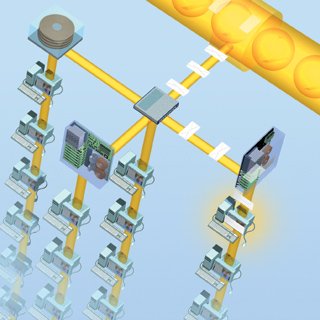Chapter 2. How Computer Networks Send Data Across the Internet
| You might take for granted that when you send a piece of information across the Internet, it will always reach its intended destination. However, the process of sending that information is remarkably complex. When you send information across the Internet, the Transmission Control Protocol (TCP)the language computers use when communicating over the Internetfirst breaks the information up into packets, smaller blocks of information that also contain a variety of data that helps the packets travel across the Internet. Your computer sends those packets to your local network, Internet service provider (ISP), or online service. From there, the packets travel through many levels of networks, computers, and communications lines before they reach their final destinations, which might be across town or around the world. A variety of hardware processes those packets and routes them to their proper destinations. This hardware is designed to transmit data between networks and makes up much of the glue that holds the Internet together. Five of the most important pieces of hardware are hubs, bridges, gateways, repeaters, and routers. Hubs are important because they link groups of computers to one another and let computers communicate with each other. Bridges link local area networks (LANs) with one another. They enable data destined for another LAN to be sent there, while keeping local data inside its own network. Gateways are similar to bridges, but they also translate data from one type of network to another. When data travels across the Internet, it often crosses great distances, which can be a problem because the signal sending the data can weaken over the distance. To solve the problem, repeaters amplify the data at intervals so the signal doesn't weaken. Routers play a key role in managing Internet traffic. Their job is to ensure the packets always arrive at the proper destination. If data is being transferred among computers that are on the same LAN, routers often aren't necessary because the network itself can handle its internal traffic. Routers come into play when the data is sent between two different networks. Routers examine packets to determine their destinations. They take into account the volume of activity on the Internet, and they send the packet to another router that is closer to the packet's final destination. For more information on routers see Chapter 6, "How Routers Work." All this hardware connects the many networks that make up the Internet. Corporate LANs are at the most local level of networks. Midlevel networks hook together these LANs using high-speed telephone lines, Ethernet, and microwave links. A regional network is a midlevel network in a geographic area. A wide area network (WAN) is another type of midlevel network. A WAN consists of an organization with many networked sites linked together. When a packet travels from a computer on a LAN in a midlevel network to a computer somewhere else on the midlevel network, a router (or a series of routers) sends the packet to its proper destination. However, if the destination lies outside the midlevel network, the packet is sent to a network access point (NAP), where it is sent across the country or the world on a backbone. High-speed backbones such as the vBNS (very high-speed Backbone Network Services) can transmit data at an exceedingly high rate155 megabits (millions of bits) per second (Mbps) or higher. Even faster backbones are being built that will transmit data at an astonishing 9.6 billion bits per second. |
EAN: 2147483647
Pages: 223
